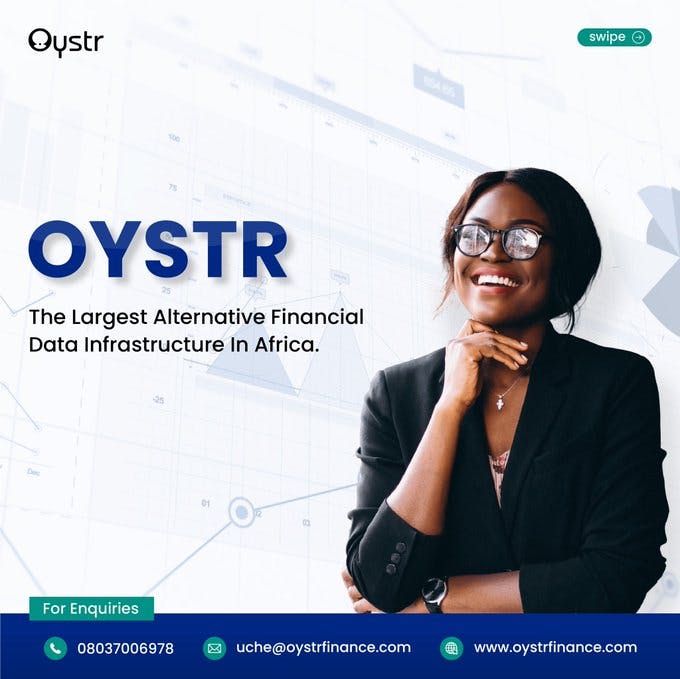As the countries of the world continue to develop, it becomes increasingly difficult for people and businesses alike to access financial services.
In Africa, the financially underserved refer to the 4.5 billion people who do not have adequate access to a range of services, including social, health and education. These are all forms of poverty and are the highest in Sub-Saharan Africa, where the population is predominantly rural, elderly and poor
In serving these groups, there’s a need to access the value of alternative data to financial organizations. Businesses and investors use alternative financial data to extract important insights, develop business possibilities, enhance deal sourcing, and influence investment choices.
Alternative Data as an Enabler of Financial Inclusion
Credit information is essential to the development of a thriving financial sector. Many lenders lack sufficient or complete credit data to give tailored finance to Africa’s unbanked/underserved. African businesses need to overcome information challenges and also access advanced financial services. Major challenges include a lack of sufficient or complete credit data and information sharing across businesses. Fintechs, who aim to solve these problems, are leveraging various sources of customer data with processing power to create innovative financial services that reach customers worldwide.

The majority of financially excluded persons rely on informal financial services, which are exacerbated by a lack of economic infrastructure. A major portion of the African population cant access credit/loans, largely due to a lack of credit history and other traditional data sources.
The fast rise of mobile banking in Africa has recently enhanced financial inclusion across the continent. Resulting in benefits for a considerable part of the population.
The continent is witnessing an increase in the footprint of digital and economic services. Lenders can use alternative transaction data to offer more inventive loan choices.
With the recent implementation of Open Banking in countries such as Nigeria, banks, fintech, and lending firms can collaborate to deliver financial inclusion chances to underserved populations through data sharing.
Serving the Underserved
Not all underserved are impoverished; it is critical to recognize this to effectively identify how to assist them. Many prefer not to utilize traditional financial institutions because they do not trust them. The essential truth, though, is that life is far more difficult for the vast majority of the unbanked. It’s more difficult to cash cheques or pay expenses. To transmit money to another person, the unbanked must utilize money orders. These have hefty costs and can take a long time to process.
Furthermore, people must carry cash without a bank rather than a more secure debit or credit card. If stolen or lost, the card can be replaced, but if money is taken or lost, it is gone forever.
When it comes to most internet transactions, cash is also out of the question. As a result, consumers are unable to utilize internet sites that typically offer more competitive rates or services without a debit or credit card.

Here’s how to serve the underserved:
Choose Oystr
The unbanked or underserved are not always unsafe or unproductive consumers. They just lack the credit history data that lenders need to determine their creditworthiness.
Oystr allows you to check the creditworthiness of non-traditional consumers who go beyond credit scores and income checks. Traditional credit rating methodologies are difficult to apply to the unbanked because they lack a clearly recorded financial or banking history.
However, to counter this, more forward-thinking financial institutions are employing alternative data. This is to assess credit risks, such as examining behavioral data from clients’ smartphones and web behavioral metadata.
Making Use of Data Technology
Reaching the unbanked necessitates high-volume delivery of services. Through applications or online, building physical branches is not cost-effective, especially in distant or rural locations. Due to the sheer scale of the unbanked, it is necessary to be able to handle large numbers of consumers cost-effectively and swiftly across massive data sets.
Furthermore, teaching customers about the financial services they demand will necessitate the use of automated recommendation engines. Again, this emphasizes the importance of a fast data layer.
Increase Mobile Offerings
There are already over three billion cell phones in use worldwide. This figure is anticipated to rise by several hundred million in the coming years. Mobile phone penetration in Africa is strong, and Sub-Saharan Africa has the fastest expanding mobile phone market in the world.
Sub-Saharan Africa has 747 million SIM connections, accounting for 75% of the population. With smartphone sales in Africa accounting for 6.6% of the worldwide market.
Mobile banking apps that allow customers to open accounts, check balances, transfer money, pay bills, and make deposits are required.
How Alternative Data Help Serve the Underserved
Alternative data plays a huge role in serving the underserved. Here are a few ways alternative data can increase financial inclusion.

Create Credit Availability
Data sharing provides lenders with access to various credit data scoring methods. The system would make credit available to the unbanked more quickly, cheaply, and credibly. Due to the underbanked relying on cash and having no traceable financial history, credit scoring systems must rely on several behavioral factors.
Data from smartphones, such as contact lists, monthly utility bills, mobile money transactions, and agent banking, might be used. Using alternate consumer data sources to reach the unbanked will improve their access to financial services.
Making Smarter Credit Decisions
Properly designed data exchange capabilities can generate alternative financial data to assist lenders and customers. This enables lenders to make more educated credit choices while addressing a broad population of the underserved and extending access to credit, allowing customers to obtain what they can afford.
Improved Credit Management Through Technological Innovation
Traditional credit scoring is no longer effective for converting heavy files into tones. A marketplace solution based on APIs enables enterprises with data sharing capabilities to contribute and consume data. This facilitates reaching a broader pool of underserved clients and fosters financial inclusion.
Mobile and Internet Penetration Surpasses Services Penetration
Many people who have had no meaningful access to formal financial services are leaving digital footprints that financial service providers can collect. It is further analyzed to reach them with commercially viable services that help them improve their lives.
This possibility is also made feasible by machine learning and big data approaches that were not available to us just a few decades previously.
Open Banks as a Means of Gathering Data
Open banking is a data-sharing environment that is private, protected, and encouraged by regulators. This is to increase competition and boost innovation in financial services. In an open banking ecosystem, incumbent banks and other financial institutions such as digital banks and telco mobile money providers share customer data with other financial services providers or third-party providers such as fintech.
The data exchange occurs under a strictly controlled privacy framework based on customer permission. Through the use of application programming interfaces, a range of third-party financial service providers can have access to client financial data stored by a bank or telecom via open banking (APIs).
It accelerates a service provider’s time to market by reducing the requirement for back-end applications to modify current data architecture. Third parties utilize APIs to aggregate several data sources to develop more comprehensive client credit profiles and more suitable financial services products. Open banking solutions need data exchange, yet most unbanked people have no digital financial profiles or data trails. As a result, it is critical to investigate how open banking ecosystems may exploit various sorts of digital data. This data is obtained from mobile phones, such as social media activity, airtime purchases, and utility payments.
With over 320 million users offering a single point of integration, mobile money wallets are a crucial driving factor in Africa. Fintechs and other types of financial institutions can do a better job than traditional banks by offering products and promoting financial behavior. This elevates some of the pain points experienced by unbanked and underserved customers. Thus, responsibly sharing their customers’ digital financial data.
Conclusion
With alternative data, we can move closer to financial inclusion in Africa. Using payment histories such as rent, cell phone, and utility payments gives an alternative view of consumer financial behavior. Importantly, these services enable individuals to prove their creditworthiness in weeks rather than years. By accelerating and innovating how financial institutions determine credit worthiness, these companies and others are increasing financial inclusion and spurring economic growth in Africa. Oystr Finance is a grand alternative data infrastructure in Africa. Financial operators can easily access alternative data with Oystr and begin to serve the underserved

